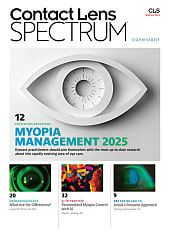For those of us in clinical practice, the use of diagnostic, or trial, contact lenses is customary. These must be disinfected prior to storage and use on another patient. Contact lens practitioners face the threat of transferring potential pathogens from one patient to another when reusing diagnostic contact lenses on multiple patients in practice.
Fortunately, the American Optometric Association’s (AOA) Contact Lens & Cornea Section and The American Academy of Optometry’s (AAO) Section on Cornea, Contact Lenses and Refractive Technologies recently created Guidelines for Handling of Multi-Patient Contact Lenses in the Clinical Setting (2019). Standards from the 2018 International Organization for Standardization (ISO) 19979:2018(E) were applied. Clinically, practical standardized guidelines are necessary to help minimize the risk of conveying infection through diagnostic lens use and reuse.
These guidelines specify contact lenses into three categories for disinfection purposes. Soft contact lenses (hydrogel) include both silicone hydrogels and HEMA hydrogels. GP contact lenses include corneal and scleral lenses. Hybrid contact lenses (composite) are composed of a GP center attached to an outer “skirt” made of a soft lens material.
Diagnostic Lens Cleaning, Disinfection, and Disposal
The guidelines recommend that all diagnostic lenses be rubbed with a daily surfactant cleaner according to manufacturer instructions. The aim of a daily cleaner is to clean—not disinfect—contact lenses. It removes particulate matter, deposits, and debris from the contact lens to ensure more effective disinfection. Products such as multipurpose (MPS) or saline solution may be used to rinse off the daily cleaner.
Following cleaning, visually inspect diagnostic lenses for any damage or defects. Discard damaged lenses. Otherwise, disinfect them.
Disinfecting GP or PMMA Lenses Use a commercially available hydrogen peroxide disinfecting solution currently approved for contact lenses. The 2018 ISO standard recommends a three-hour soak in non-neutralized ophthalmic-grade 3% hydrogen peroxide. Lenses are then rinsed with sterile saline or MPS and stored dry. Avoid tap and well water at all times due to potential Acanthamoeba contamination.
Soft and Hybrid Contact Lenses Follow the same hydrogen peroxide soaking instructions as listed above for GP lenses. After the three-hour soak time, neutralize the solution according to manufacturer guidelines. After neutralization, the lens should be rinsed with saline or MPS and stored. This lens disinfection guide is available below.

When transferring a lens, use a sterile cotton swab or contact lens tweezers. MPSs can be used to store diagnostic lenses in sealed containers. Label diagnostic lenses with the disinfection date. If not used, the 2018 ISO Standards suggest repeating the disinfection every 28 days.
Moist heat disinfection is an option for hydrogel lenses but never for hybrid lenses. According to 2018 ISO standards, place a lens into 0.9% sodium chloride solution in a borosilicate glass vial with crimped seal. Disinfect with a target temperature of 134°C for a minimum of three minutes or 121°C for a minimum of 15 minutes. Ensure that the lens is clean prior to heat disinfection because any debris or deposits on the lens surface can be boiled onto the lens.
If not provided, practitioners should seek guidelines from manufacturers on the criteria for discarding diagnostic lenses. Manufacturers can provide the number of times that diagnostic lenses can be re-used and/or the expiration date of diagnostic lenses after first use. CLS
The author thanks Drs. Christine Sindt, Ed Bennett, Loretta Szczotka-Flynn, and Louise Sclafani for their contributions to this article.
For references, please visit www.clspectrum.com/references and click on document #290.





